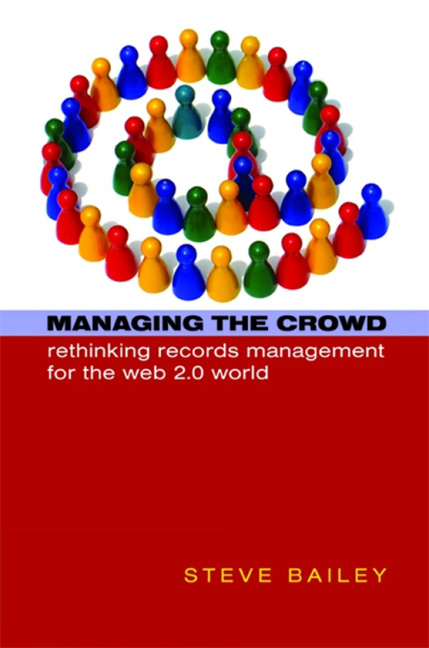Book contents
- Frontmatter
- Dedication
- Contents
- Foreword
- Preface
- Part 1 The Nature Of The Changing World
- Part 2 Is records management no longer fit for purpose?
- 5 The need for critical professional self-examination
- 6 ‘Not all information sources are records’
- 7 The centralized command and control ethos
- 8 ‘Regardless of format...’
- 9 Appraisal, retention and destruction
- 10 The problems with applying existing approaches to appraisal in the Web 2.0 world
- Part 3 Records Management.0 And The Future Of Records Management 121
- Index
10 - The problems with applying existing approaches to appraisal in the Web 2.0 world
from Part 2 - Is records management no longer fit for purpose?
Published online by Cambridge University Press: 08 June 2018
- Frontmatter
- Dedication
- Contents
- Foreword
- Preface
- Part 1 The Nature Of The Changing World
- Part 2 Is records management no longer fit for purpose?
- 5 The need for critical professional self-examination
- 6 ‘Not all information sources are records’
- 7 The centralized command and control ethos
- 8 ‘Regardless of format...’
- 9 Appraisal, retention and destruction
- 10 The problems with applying existing approaches to appraisal in the Web 2.0 world
- Part 3 Records Management.0 And The Future Of Records Management 121
- Index
Summary
Questions addressed in this chapter
• Why are our current appraisal techniques not scalable enough for use in a Web 2.0 environment?
• Why is it not enough to just consider the evidential significance of an information source when considering its value?
• How much can we expect from information creators and users during the appraisal process?
Appraisal theory and reality
Firstly, we must acknowledge that it is over-simplistic to assume that there currently exists just one universally accepted view of appraisal and retention management. In fact, as you would expect with a profession dealing with such a wide variety of record and information types within a broad spectrum of sectors and organizations, there is a considerable diversity of theoretical opinion and practical application. Such diversity is a healthy recognition of the fact that ‘one size does not fit all’, and is to be welcomed. It can, however, make for a confusing landscape, especially as it would be a mistake to assume that approaches to appraisal are necessarily clearly and cleanly defined. Theories merge and overlap and circumstance often dictates a pragmatic approach that includes elements of more than one methodology.
On a more general level, the one factor common to all approaches is the need to recognize the potential gulf between established theory and practical reality. It is often said that politicians believe that announcing the introduction of a new policy automatically equates to the successful implementation of that policy, whereas, in reality, there is often a considerable gulf between the two. Perhaps, the same could be said to apply to much of our thinking with regards to appraisal. Just because we have a well established theory does not mean that it really has the impact we might hope for in reality. Our approach to e-mail appraisal is a classic example of this. I have attended several conferences and events on this topic, full of earnest presentations from the podium about the importance of identifying and retaining only the small percentage of e-mails that count as records, and then have overheard the conversations over coffee where these same people admit that users within their organizations (sometimes even themselves) openly hoard countless.
- Type
- Chapter
- Information
- Managing the CrowdRethinking records management for the Web 2.0 world, pp. 109 - 120Publisher: FacetPrint publication year: 2008



